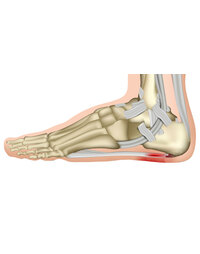WHAT IS PLANTAR FASCIITIS?

| Sometimes referred to as "policeman's heel" or heel spur, Plantar Fasciitis is an inflammatory condition that causes chronic pain in the heel of the foot (and sometimes in the arch). It is the most common foot complaint in Australia with over 800,000 people suffering each year! Plantar Fasciitis is Latin for Ôinflammation of the plantar fascia' - referring to the fibrous ligament under the foot, running from the heel bone to the toes. Symptoms For most people the pain is at its worst when taking your first steps out of bed in the morning.Ê It is usually a sharp, stabbing pain at the bottom or front of the heel bone. The pain is more severe after long periods of inactivity (sitting, driving or sleeping). Once you start moving throughout the course of the day the pain typically diminishes, transforming into a lingering, dull ache.  What causes Plantar Fasciitis? Plantar Fasciitis is primarily caused by an Ôabnormal foot function' - in particularÊ over-pronation (rolling in of the foot) and in some cases by high arches. The most common contributory factors include: ¥Ê Êage ¥Ê weight gain ¥Ê a job that requires standing or walking on hard surfaces for extended periods of time (including nursing) ¥Ê Êunsupportive footwear ¥Ê Êpregnancy How pain occursÉ The Plantar Fascia is a band of tissue under your foot running from your heel to your toes.Ê In over-pronating feet, the Plantar Fascia is excessively stretched with every step, which results in inflammation, irritation and pain where the Fascia attaches to the heel bone.Ê In some cases, the pain even extends into the arch of the foot.ÊThis perpetual pulling of the Fascia at the heel bone leads to pain and inflammation. It may also lead to the development of a bony growth in the heel, called a Ôheel spur'. As you rest (for example, when you're asleep), the Plantar Fascia becomes shorter and tighter.Ê The moment you get up, all of your body weight goes straight to your feet, forcing the Fascia to immediately stretch and lengthen which causes micro-tears in the tissue.Ê This is why pain is the most severe during your first few steps in the morning or after long periods of rest. Treatment for Plantar Fasciitis ¥Ê rest (avoid high impact sports, running, walking long distances and standing for long periods of time) ¥Ê ice (2-3 times a day for 5-10 minutes at a time) ¥Ê a daily, targeted exercise program ¥Ê anti-inflammatories (e.g. Ibuprofen) ¥Ê cortisone-steroid injections (usually performed by a GP directly into the heel bone, not pleasant!!)  Orthotic insoles For long-term, sustainable pain (and more natural) relief, you must treat the cause of the problem: abnormal foot mechanics.Ê This is exactly what orthotic insoles do. Orthotics can be custom-made and prescribed by a podiatrist. However, for most cases of Plantar Fasciitis a so-called Ôpre-made' orthotic insole can be very effective. Footlogics orthotics were developed by Australian podiatrists to support the arches of the feet and control over-pronation.Ê They help minimise and release the tension on the Plantar Fascia thereby targeting the source of the problem and allow the inflamed tissue to heal faster.Ê For added comfort and relief from pain, Footlogics orthotics also have a shock-absorbing heel pad that reduces the level of impact on your heel as you walk. Stretching exercises Recent studies have shown that the most effective long-term treatment for Plantar Fasciitis is a combination of wearing orthotic insoles and performing a series of daily exercises.Ê Specific, targeted exercises lengthen and increase the flexibility of the muscles and tendons in the feet, which thereby reducesÊ the tension placed on the Plantar Fascia.Ê We recommend calf stretches, rolling a ball under the foot and towel stretches. There's a short video on YouTube about Plantar Fasciitis here: https://www.youtube.com/watch?v=aSswRajiA6A |




